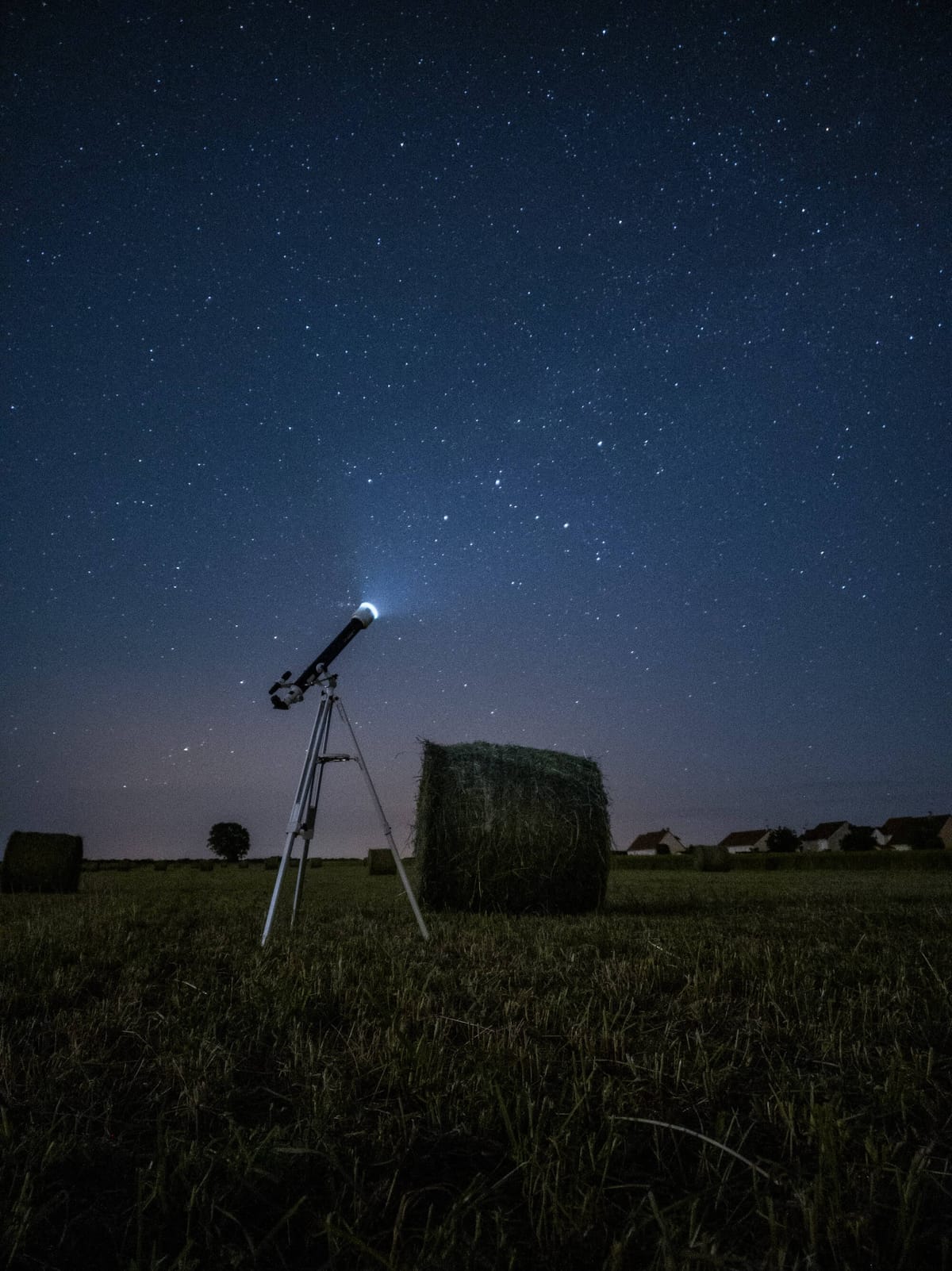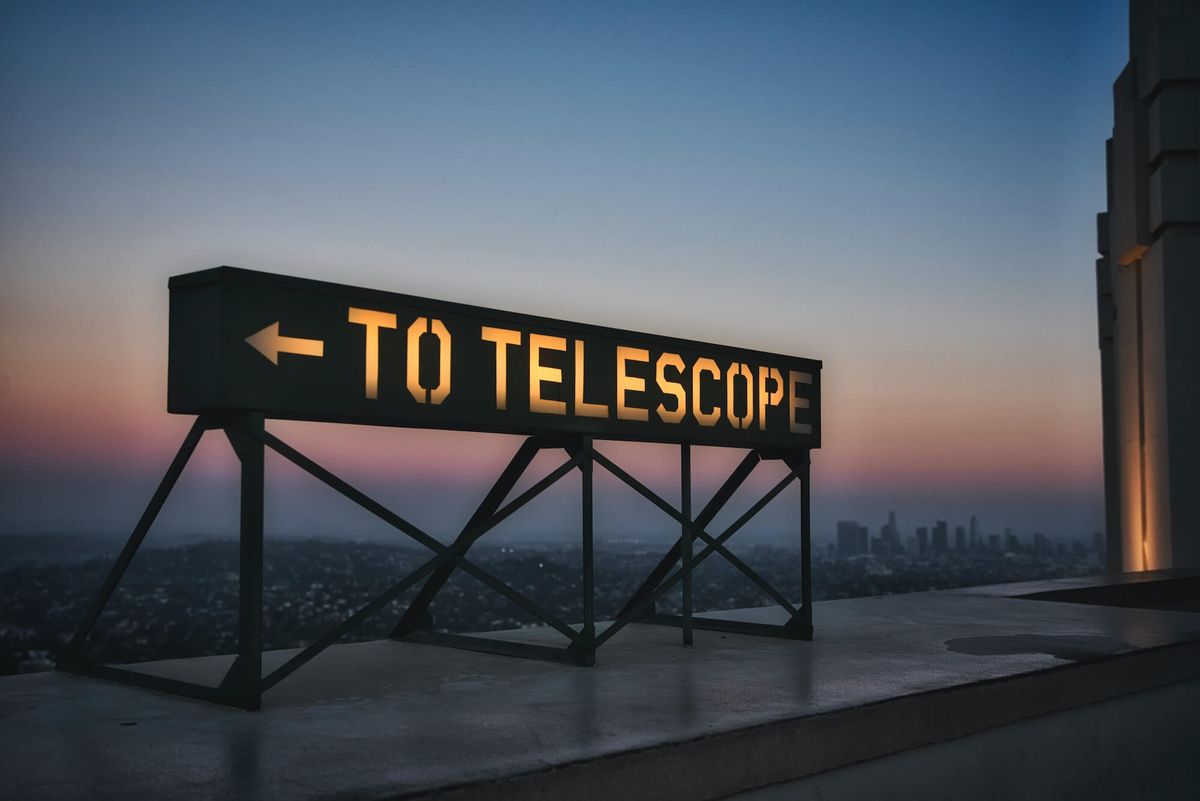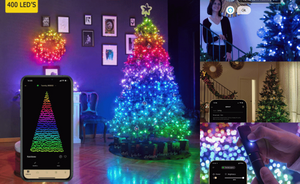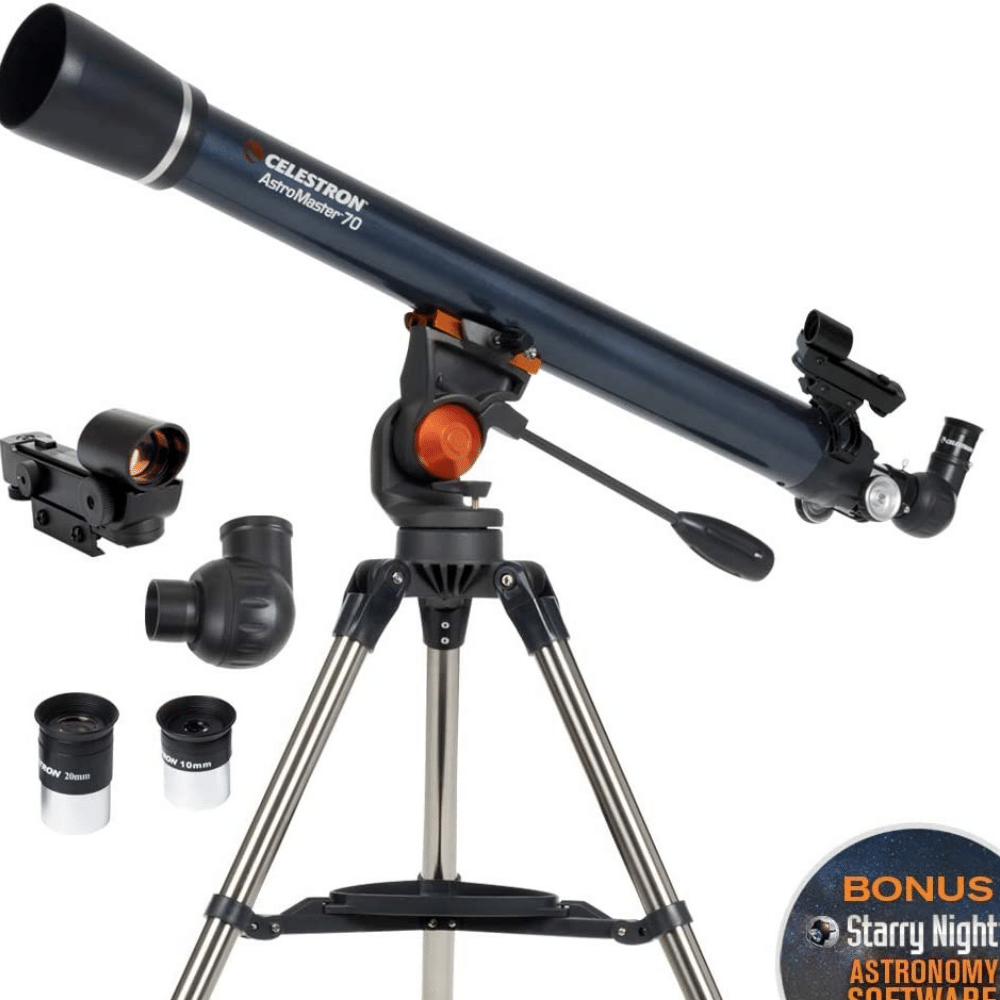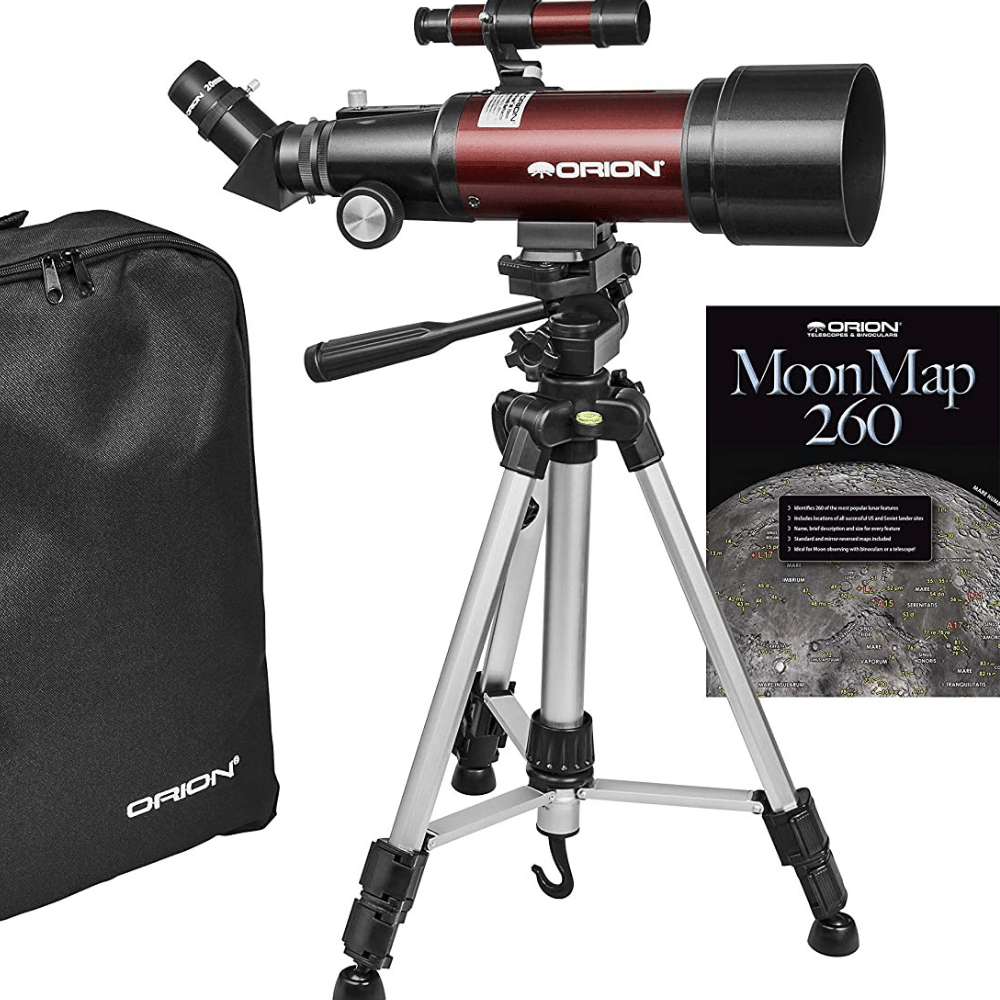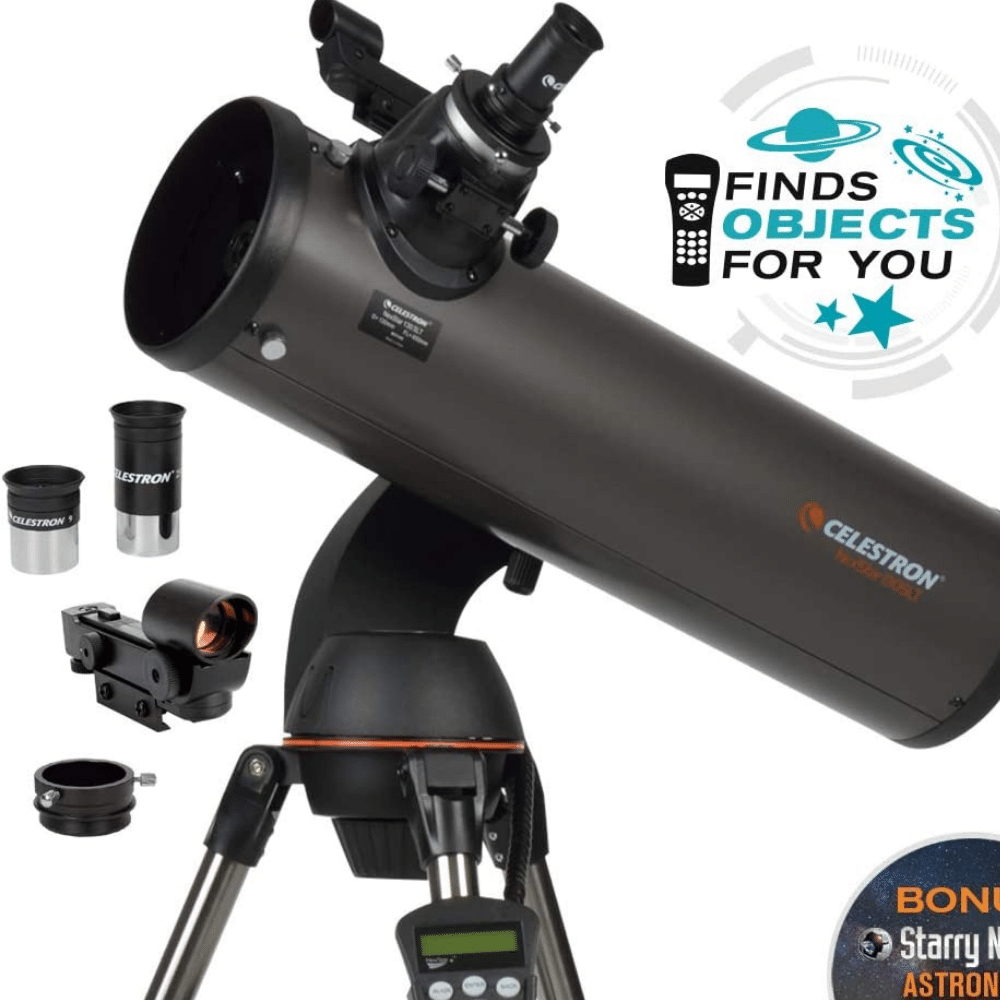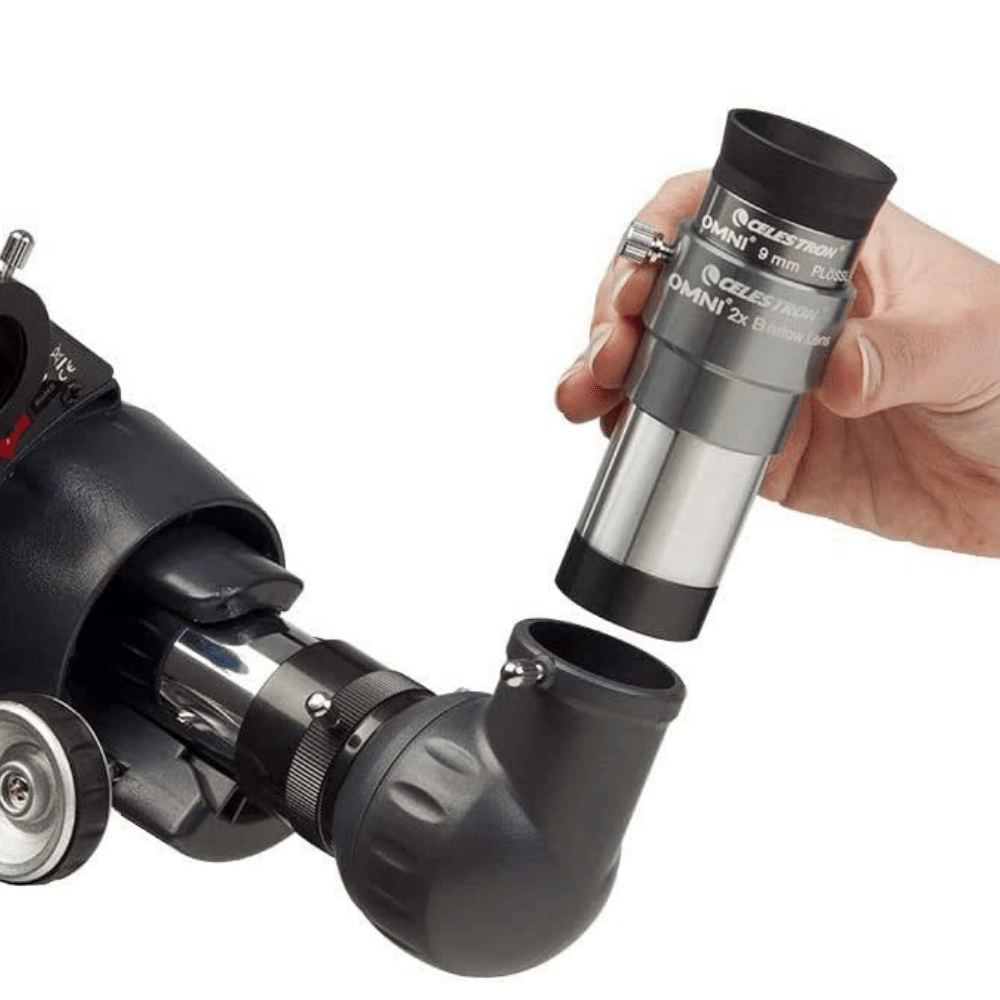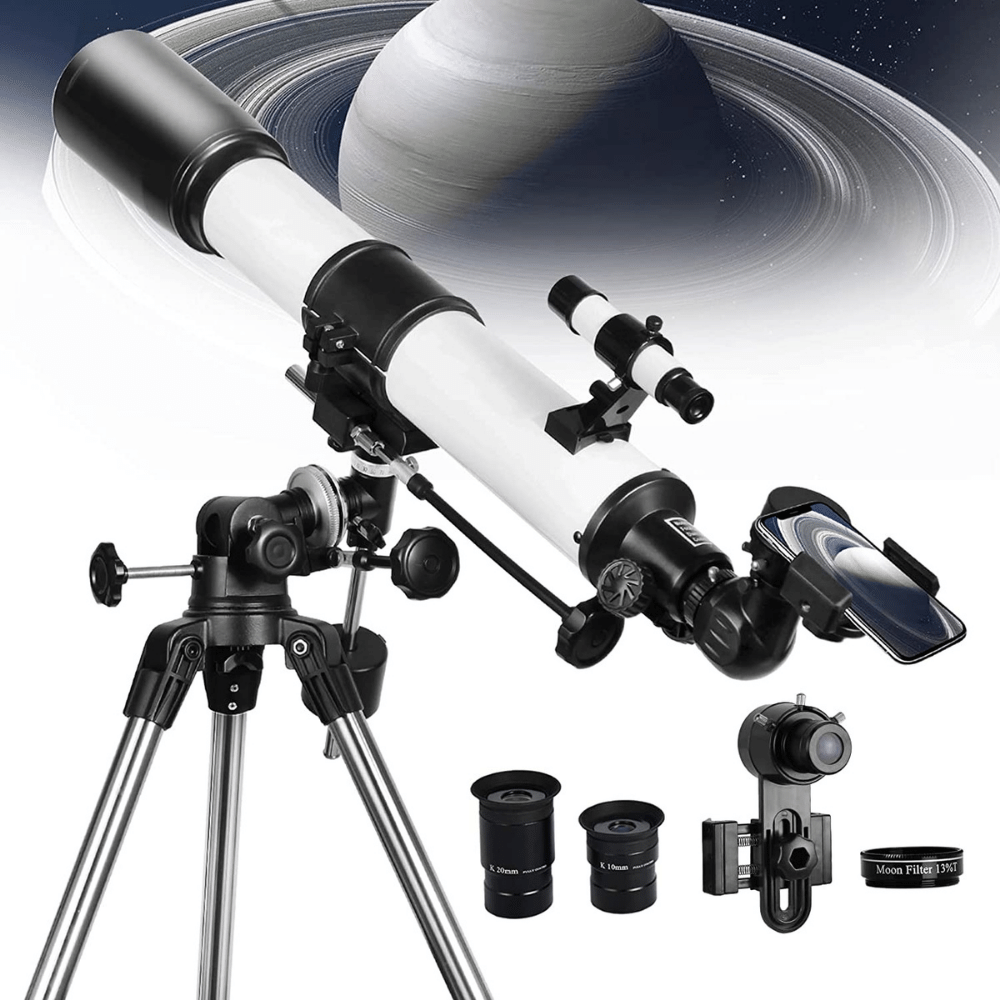A telescope is a powerful tool that can help your child explore the night sky.

With a kids telescope, your child can see distant stars and planets up close.
Through exploration and observation, your child can learn about the wonders of the universe with a telescope for kids!
A kids telescope or sometimes, even toy telescopes, can also be used to view eclipses, comets, and other celestial events or take high-quality images and pictures of the starry sky.
With a beginner telescope, your child can explore the gorgeous starry sky and discover the wonders of the universe.
In this blog post, we'll recommend the best telescopes for kids and explain what features to look for when choosing the best kids telescopes for your young kids and family.
What to Look For When Choosing a Telescope for Your Child
There are a few things you'll want to keep in mind when choosing a kid's telescope, whether you are looking for a tabletop telescope, a toy telescope, an inexpensive telescope or the best toy telescope, we will talk about the best telescopes for kids in this blog.
Younger kids will likely be more interested in wanting to find objects in the sky, looking at planets and bright stars, while an older child may be more interested in lunar and solar eclipses or deep-sky objects like nebulae and galaxies.
You'll also want to think about the type of mount you want for the telescope.
If you're just getting started in astronomy, you might be wondering what kind of telescope mount is best for you.
There are a few different types of mounts, but one that is especially well-suited for beginners is the Dobsonian mount.
This type of mount is very simple to set up and use, which makes it a great option for those who are new to the hobby.
So if you're looking for an easy-to-use and affordable children's telescope mount, a Dobsonian is the way to go.
Altazimuth mounts are simple in design and easy to operate, making them a good choice for beginner stargazers.
This mount consists of two axes - one horizontal and one vertical - that move independently of each other.
This allows the telescope to be pointed in any direction, making it easy to find and track celestial skies.
In contrast, equatorial mounts are more complex, and require the user to align the mount with the North Star before use.
As a result, both types of mounts have their own pros and cons, and it ultimately comes down to personal preference.
Whichever mount you choose, make sure to take some time to learn about the starry night so you can get the most out of your new telescope, find a fun moon map! Link On AMAZON?
Finally, you'll want to decide how much you're willing to spend on a telescope.
While it's possible to get a good quality telescope for under $100, you may need to spend closer to $200 if you want something that will grow with your child as their interest in astronomy increases.
The best telescopes for kids are ones that are simple to set up and use, provide clear images of celestial objects, awesome lunar and planetary viewing and are within your budget.
With so many great telescopes on the market, you're sure to find one that's perfect for your family.
How We Choose!
We know that finding the best telescopes for kids can be an interesting learning curve and we are here to help!
That’s why we’ve done all the hard work for you and found some of the best telescopes on the market.
Your child is just starting out in astronomy or is looking to take their hobby to the next level, we have the best telescopes for kids to show you!
With our selection of telescopes, your child will be able to see farther into space than they ever thought possible.
They’ll be able to explore different galaxies, planets, and stars – and learn about them all in an exciting and fun way.
Keep reading to now to find the perfect telescope for your child!
Celestron 21061 AstroMaster 70AZ Refractor Telescope
What's Amazing!
The Celestron 21061 AstroMaster 70AZ Refractor Telescope is perfect for kids who are interested in getting started in astronomy.
With its 70mm aperture, the Celestron 21061 AstroMaster 70AZ Refractor Telescope can reveal a wealth of detail in objects like planets, stars, and galaxies.
The Celestron 21061 AstroMaster 70AZ Refractor Telescope is a great choice for beginner stargazers.
This telescope is relatively inexpensive, easy to set up and use, and produces clear images of astronomical objects with two eyepieces.
With its altazimuth mount, this telescope is perfect for beginners who want to explore the Stars above.
What's Impressive!
- The Celestron 21061 AstroMaster 70AZ Refractor Telescope is perfect for beginner stargazers.
- This telescope comes with two eyepieces , so your child can experiment with different magnifications.
The two eyepieces are 25m and 10mm focal length.
The 25mm eyepiece is for viewing the wide sky, such as star clusters and galaxies. With these multiple eyepieces, and the long tube attached, you'll be observing planets in no time!
The 10mm eyepiece is for viewing the Moon and planets, which gives you greater magnification and detail. For example, you can use the 10mm eyepiece to view craters on the Moon.
This children's telescope with multiple eyepieces allows distant objects to become the focal point of deep space objects found on moon maps and starry night astronomy software you can check out with the smartphone adapter!
- The AstroMaster also features a motor drive, which keeps the telescope pointed in the same direction as you move it.
- This telescope is easy to set up and use, has two eyepieces to look through and it's a great way to introduce your child to the wonders of the universe.
Orion 10034 GoScope II 70mm Refractor Travel Telescope
What's Amazing!
The Orion 10034 GoScope II 70mm Refractor Travel Telescope is perfect telescope for kids who want to take their telescope and adjustable tripod with them wherever they go.
The 70mm refractor lens provides clear images of the galaxies above, and the included erect-image diagonal ensures that your views are correctly oriented.
With the Orion 10034 GoScope II 70mm Refractor Travel Telescope, your child can explore the wonders of the huge universe anywhere they go!
The Orion 10034 GoScope II 70mm Refractor Travel Telescope is perfect for on-the-go stargazing.
With its wide-angle view, the GoScope II is great for viewing celestial objects like the moon and stars for your young astronomer that you can find with starry night software.
What's Impressive!
The Orion 10034 GoScope II 70mm Refractor Travel Telescope is perfect for amateur astronomers who want to enjoy clear images of astronomical objects while on the go.
These kids telescopes are easy to set up and use, and it's small enough to fit in a backpack or carry-on bag and easy for young kids.
This is a kids telescope suitable for being the best beginner telescope!
It also has an internal battery that can last up to four hours on a single charge.
The Orion 10034 is a really cool telescope tube for kids that also comes with a built-in camera mount that allows you to take pictures of the night's incredible sky.
Celestron NexStar 130SLT Computerized Telescope
What's Amazing!
This is a professional telescope that comes with many features. Younger kids may need a bit of help setting up this compound telescope.
This durable telescope comes with a fully computerized system, and you can use it to locate over 4,000 celestial bodies and distant objects.
The Celestron NexStar 130SLT Computerized Telescope is the most expensive option on this list, but it's also the most feature-rich.
This model allows you to see more than 4,000 celestial objects such as planets and nebulae.
The high tech telescope comes with a computerized hand control that allows your child to automatically locate and track astronomical objects.
What's Impressive!
The Celestron NexStar 130 SLT Computerized Telescope is the perfect introductory telescope for any child.
This computerized telescope comes with a database of over 4,000 celestial and distant objects, so your child can always find something new to look at.
The NexStar 130 SLT also has automatic alignment technology, which means that it will find things in the sky for you!
With a quick push of a button, you can have this great telescope align itself and be ready to use in mere seconds.
This Celestron telescope is perfect for amateur astronomers who want to explore the wonders of space.
It also features an easy-to-use hand control and finder scope that makes it easy to navigate the big night ceiling and star clusters!
So if you're looking for a telescope that's fun and easy to use, the Celestron NexStar 130SLT Computerized Telescope is perfect for our child's very own telescope!
Celestron Omni 2X Barlow Lens
What's Amazing!
The Celestron Omni 2X Barlow Lens is a must-have accessory for any astronomer.
It doubles the magnification of each eyepiece you own, while keeping the eye relief intact.
This means that you can get a closer look at celestial beings and objects without sacrificing comfort.
Plus, it's backed by Celestron's legendary service and support.
Whether you're a beginner or a seasoned pro, the Omni 2X Barlow Lens will help you get the most out of your telescope.
What's Impressive!
The Celestron Omni 2X Barlow Lens is a high-quality optical device that gives you the power to see things in a whole new light.
This nifty little lens slides right into 1.25 inch focusers and diagonals and accepts 1.25 inch eyepieces, making it the perfect tool for any amateur astronomer or birdwatcher.
With its fully multicoated optics and blackened edges, the Celestron Omni 2X Barlow Lens provides good light transmission and minimal reflections for a crisp, clear view of whatever you're looking at.
Whether you're gazing at the stars on a clear night or trying to get a better look at a faraway object, the Celestron Omni 2X Barlow Lens is an essential addition to your collection of optics.
SOLOMARK Telescope, 80EQ Refractor Professional Telescope -700mm Focal Length Telescopes for Adults Astronomy, with 1.5X Barlow Lens Adapter for Photography and 13 Percent Transmission Moon Filter
What's Amazing!
The SOLOMARK Telescope, 80EQ Refractor Telescope -700mm Focal Telescope is the perfect telescope for beginners.
It is an easy-to-use and powerful telescope that gives the first-time telescope user the good combination of quality, value, features, and power.
The Manual German Equatorial Mount makes it easy to navigate the sky with our refractor telescope.
The large slow-motion control knobs make it easy to track objects smoothly and seamlessly as they drift across the nighttime sky.
What's Impressive!
This powerful refractor telescope has a 700mm focal length and comes with 2 eyepieces (10mm and 20mm) for different viewing options.
This Solomark telescope also includes an erect image diagonal, finderscope, 13% moon filter, and a smartphone adapter for phone photography and an accessory tray!
Plus, with the included Barlow lens, you can triple the power of each eyepiece.
So whether you're an experienced stargazer or just getting started, this telescope is perfect for anyone who wants to explore the night's huge ceiling of stars!
Best Telescope for Kids FAQs
Which type of telescope is best for kids?
There are a few different types of telescopes that are good for kids.
Reflector telescopes also tend to be less expensive than other types of telescopes.
Refractor telescopes are also good for kids, and they allow you to see more detail than refractors.
For example, refracting telescopes are simpler in design and usually more portable, but they suffer from chromatic aberration, which causes objects to appear distorted.
Reflecting telescopes, on the other hand, do not suffer from chromatic aberration, but they require a more sturdy tripod to support the weight of the mirror.
Once you have chosen the right type of first telescope, you can begin to experiment with different magnification settings to get a clear view of the night sky.
Another thing to consider when choosing children's telescopes for your child is the size of the telescope.
Reflector telescopes vs. Refractor telescopes?
If you love stargazing, then a telescope is a must-have item.
With a telescope, you can get a close-up view of the moon, planets, and stars sometimes called a moon mirror.
There are two main types of telescopes: refracting and reflecting.
Refracting telescopes use lenses to magnify objects, while reflecting telescopes use mirrors.
Both types of telescopes come with two eyepieces so that you can get a closer look at what you're observing.
In addition, most telescopes have an adjustable tripod so that you can position the telescope for optimal viewing.
Whether you're interested in observing the moon and planets or distant stars, a telescope can give you an up-close look at the night sky.
A refractor telescope is a type of optical telescope that uses a lens to collect and focus light from an object, while a reflector telescope uses a mirror to do the same.
Refractors are often considered to be the superior design because the curved lenses can be made with very high quality optics, which results in brighter and sharper images.
Additionally, since the light is passing through fewer components (the lens only), there is less chance of distortion or aberration.
What is the best telescope for a 5-year-old?
Good children's telescopes for a 5-year-old would be something small, lightweight, and easy to use finder scope.
At what age can a child use a telescope?
It depends on the child's level of maturity and their ability to focus on objects for an extended period of time.
Usually, children around the age of 10 or 11 are able to use a telescope with minimal assistance.
Telescopes are a great way for kids to learn about space and the solar system with a finder scope.
Which telescope is best to see planets for beginners?
A good telescope for beginners is a reflector telescope.
Reflector telescopes are less expensive than other types of telescopes and are easy to use.
When looking at planets and other celestial objects with a telescope, it's important to remember that the brightness of the planet will vary depending on its distance from Earth.
The brightest planets will be those closest to Earth, such as Venus and Jupiter.
Planets that are further away from Earth will be fainter and more difficult to see.
Can a cheap telescope see planets?
Yes! A telescope can see planets.
However, the larger the telescope and optical tube, the better the view will be. Additionally, you'll need a clear night sky to see anything.
What are the 3 main types of telescopes?
There are 3 main types of telescopes: refracting, reflecting, and catadioptric.
Refracting telescopes use lenses to collect and focus light from an object into an image.
Reflecting telescopes use mirrors to reflect light from an object into an image.
Catadioptric telescopes use a combination of lenses and mirrors to collect and focus light from an object into an image.
What do I need to know to buy a telescope?
First, you'll need to consider what type of telescope you want.
There are three types: refracting telescopes, reflecting telescopes, and compound telescopes. See the above FAQ!
Second, you'll need to think about what size telescope you want.
The size is measured in diameter, with larger diameters providing more magnification.
Third, you'll need to decide on a price range.
Finally, once you've decided on the telescope that's best for you, the next step is to find a place to stargaze!
The moon is a great place to start - it's easy to spot and has tons of features to explore.
Other favorites include Jupiter and its four Galilean moons, Saturn with its rings and intricate moons, and the Orion Nebula - one of the most impressive nebulae in our skies.
With a little bit of practice you'll be able to find all sorts of amazing things in the night sky!
How do I choose a telescope?
When choosing a telescope, you need to consider what you want to use it for.
Are you interested in observing the night sky or taking pictures of space?
Do you want a portable telescope or one that will stay in one spot?
The most important factor in choosing a telescope is its aperture, which is the diameter of the telescope's main lens or mirror.
The larger the aperture, the more light the telescope can collect, resulting in a clearer image.
Aperture is measured in inches or millimeters.
A compound telescope is a type of telescope that uses two convex mirrors to magnify objects.
Compound telescopes are able to achieve high levels of magnification, making them ideal for astronomical research.
Other factors to consider when purchasing a telescope include focal length (measured in mm), mount type, red dot finder and price.
What is an equatorial telescope mount?
An equatorial telescope mount is a type of telescope mount that allows the telescope to rotate around two perpendicular axes, making it easier to track celestial objects as they move across the night sky.
Which is better reflecting or refracting telescope?
Generally speaking, reflecting telescopes are better for beginners as they are cheaper and easier to use, while refracting telescopes are more expensive but provide higher-quality images.
However, it is important to note that there are many other factors that need to be considered when choosing a telescope, such as aperture size, mount type, and so on.
What is the disadvantage of a refracting telescope?
A refracting telescope has a few disadvantages compared to other types of telescopes.
For one, they are bulkier and heavier than other telescopes.
Additionally, because the light passes through more glass (or other material), the image is not as sharp as it would be with a reflecting telescope.
Finally, refracting telescopes are more expensive than reflecting telescopes.
What are the disadvantages of a reflecting telescope?
A reflecting telescope has a number of disadvantages when compared to a refracting telescope.
First, the mirrors in a reflecting telescope often require more maintenance than the lenses in a refracting telescope.
The mirrors must be kept clean or they will lose their reflectivity, and sometimes they must be realigned to keep the image in focus.
Second, reflecting telescopes are generally larger and heavier than refracting telescopes.
This makes them more difficult to transport and harder to mount on a stable platform.
Third, reflecting telescopes produce more scattered light than refracting telescopes.
This can cause glare and decreased image contrast.
Do astronomers use reflecting or refracting telescopes?
Most astronomers use reflecting telescopes because they are less expensive and more compact.
Reflecting telescopes use a large curved mirror to bounce the light from an object into an eyepiece, whereas refracting telescopes use a series of lenses to bend the light into an eyepiece.
Although refracting telescopes give a sharper image, they are more expensive and bulkier than reflecting telescopes.
For these reasons, most professional astronomers tend to use reflecting telescopes.
However, there is a growing trend towards using large refracting telescopes for important research projects because of their superior image quality.
What does focal length affect in telescopes?
Telescopes are essentially magnifying glasses, and the focal length affects how much magnification the telescope provides.
A shorter focal length telescope will provide more magnification than a longer focal length telescope.
The other thing that the focal length affects is the field of view.
A shorter focal length telescope will have a wider field of view than a longer focal length telescope.
This is because a shorter focal length lens will bend light more sharply than a longer focal length lens, so the image will be spread out over a wider area.
What is meaning of focal length of a telescope?
The focal length of a telescope is the distance from the center of the lens or mirror to the point where light rays converge to produce an image within the optical tube.
This measurement is important because it determines how large an object can be viewed through the telescope and how detailed the image will be.
Telescopes with shorter focal lengths produce wider images, while those with longer focal lengths produce narrower images.
The magnification of a telescope is determined by the ratio of the focal length to the diameter of the primary mirror or lens.
So a telescope with a 1000mm focal length and a 100mm diameter will have a magnification of 10x.
For example, a telescope with a longer focal length will be able to view larger objects in greater detail than one with a shorter focal length.
And while it's possible to increase the magnification of a short-focal-length telescope by using eyepieces with a higher power rating, this will also decrease the amount of light that reaches your eye, making it more difficult to see faint objects.
What is a good focal length for a telescope?
A good focal length for a telescope is in the range of 1000mm to 1500mm. This will allow you to view objects in greater detail than if you were using a telescope with a shorter focal length.
Keep in mind that when choosing a telescope, you also need to consider the aperture size.
The aperture is the diameter of the lens or mirror at the front of the telescope, and it determines how much light your telescope can collect. So make sure to choose a model with an aperture size that is appropriate for your needs.
How does focal length affect magnification in a telescope?
The focal length of a telescope affects magnification in two ways.
The first way is that the longer the focal length, the higher the magnification will be.
This is because a longer focal length means that the image will be projected onto a smaller area, which means that the image will be enlarged.
The second way that focal length affects magnification is by affecting the eyepiece.
A shorter focal length eyepiece will give a higher magnification than a longer focal length eyepiece.
This is because a short focal length eyepiece has a wider field of view, which means that more of the image will be projected onto the eyepiece.
Where is the best place to put a telescope?
If you're looking to view celestial objects, such as stars and planets, then a location with little light pollution is ideal.
If you're using your telescope for terrestrial viewing, such as birds or wildlife, then a location with good visibility is key.
What can you see with a 5-inch telescope?
With a 5-inch telescope, you can see general features on the moon, planets in our solar system, and some of the brighter stars.
What's the difference between a smartphone mount and a smartphone adapter on a telescope?
A smartphone adapter is a small, flat disc that attaches to the eyepiece of a telescope. It holds a smartphone in place so that you can take pictures or videos of what you're seeing through the telescope.
A smartphone mount is a device that attaches to the barrel of a telescope and holds the smartphone in place. It's more stable than an adapter, and it allows you to use your phone's touchscreen to control the telescope.
What MM is best for a telescope?
A medium-sized MM is best for telescopes or optical tube.
The larger the aperture, the more light the telescope collects and the better image quality you will get.
There are two types of mounts: altazimuth and the equatorial mount.
An altazimuth mount allows the telescope to move up-and-down (altitude) and side-to-side (azimuth).
An motorized equatorial mount makes the telescope rotate around one axis, so that it always points in the same direction.
This type of mount is best for astrophotography, because it keeps the stars in the same position in the image as they move across the sky.
Telescopes Open the Minds of Everyone to Our Big Universe!
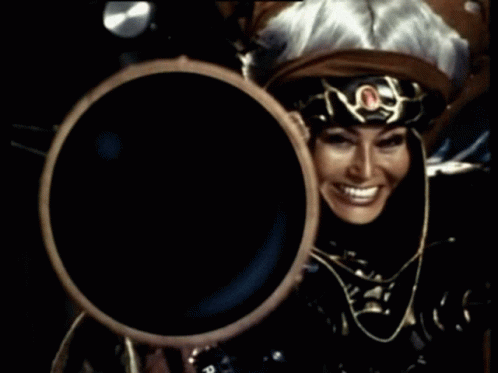
The Best Telescope for Kids For You !
So, what are the best telescopes for kids?
If you want to get them started in astronomy, a simple refractor telescope might be perfect.
But if they are more interested in terrestrial objects, consider getting them a spotting scope and starry night software.
And finally, if your child loves gadgets and wants to explore space with the latest technology, then a computerized telescope is definitely the way to go!
Whichever type of telescope you choose, make sure it’s easy to use and has features that interest your child.
With these tips in mind, finding the best telescope for kids should be a breeze! Happy shopping!
Happy stargazing!
